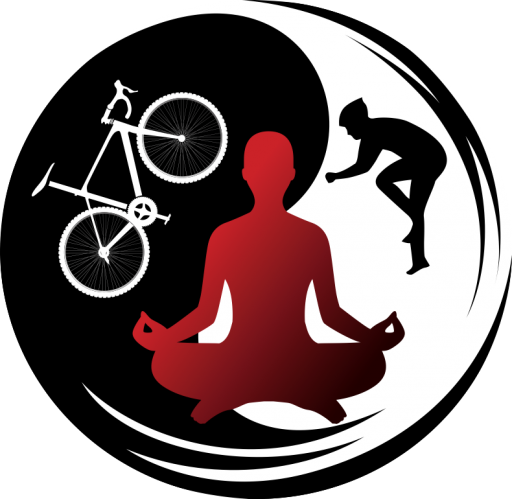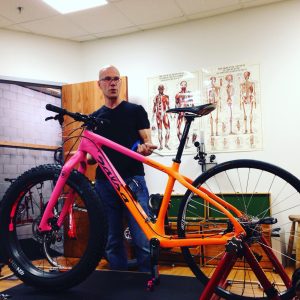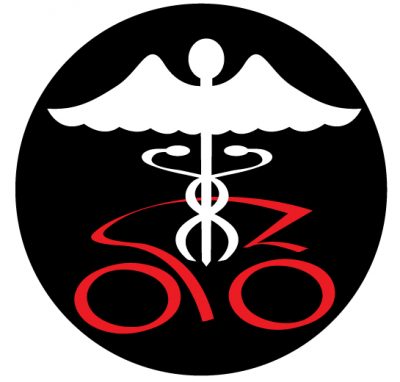PT Bike Fit?


Physical Therapists & Bike Fitting?
Why are PT’s suddenly so interested in bike fitting?
Because addressing symptoms related to a poor bike fit is lucrative; especially when prescribing therapeutic interventions intended for non-accommodative movement patterns to the accommodative movement pattern that is cycling. The “optimal” biomechanics for natural/functional movement patterns is not analogous to cycling-specific biomechanics, and without extensive knowledge and experience in the latter, applying the former boarders on unethical.
What’s the fuss?
I see 30-50- clients each year who have been in PT at least 6-months with no discernable improvement when cycling. Ironically, the majority of these folks require fundamental/ basic contact point/component changes to experience 100% resolution (for bike-related symptoms) when cycling. This phenomenon is perpetuated by the fact that said clients often don’t confront the provider or ask for a refund, so the PT-fitter has no idea he/she did anything wrong.
According to the American Physical Therapy Association:
“Physical therapists (PTs) are movement experts who optimize quality of life through prescribed exercise, hands-on care, and patient education.
Physical therapists teach patients how to prevent or manage their condition for improving and achieving long-term health benefits. PTs examine each individual and develop a plan, using treatment techniques to promote the ability to move, reduce pain, restore function, and prevent disability. In addition, PTs work with individuals to prevent loss of mobility before it occurs by developing fitness- and wellness-oriented programs for healthier and more active lifestyles.”
American Physical Therapy Association
Physical therapist are human movement specialists trained to work with bodies. Humans are the only bipedal species featuring lumbar lordosis, arranging the sacrum and hips in a way that allows us to walk upright and function on two-legs. PT’s note symptoms and design functional interventions based on the human anatomical model, which makes the objective optimal anatomical function. Emphasis is on changing to the body — not bike.
Cycling, although a great form of exercise, is not conducive to optimal anatomical function. Humans do not naturally move in a horizontal position with hands bearing upper body mass, legs moving in a fixed/circular pattern with a saddle rewarding pelvic symmetry. In fact, we function more like primates when cycling — without the anatomical advantages. For example, the gluteus medius on primates is located posterior and functions to extend the hip; on humans, it is located on either side of the hip to maintain pelvic obliquity in gait.
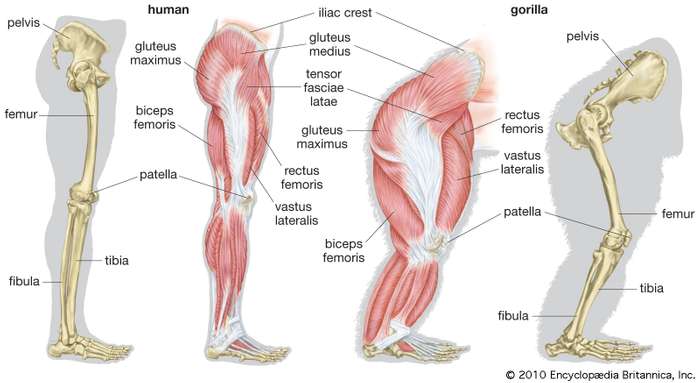
Lateral knee pain is common in cyclists, often misdiagnosed as one or both “weak “gluteus medius muscles.” This is based on the idea that iliotibial band tension increases as the tensor fasciae latae (attached to the ITB) compensates for compromised gluteus medius function. :
As you can see in the diagram, the gluteus medius origin and insertion in humans keeps the opposing hip from dropping in bipedal/upright posture, but it is not required in a quadruped (cycling) position where the spine is more horizontal than vertical. It contributes to pelvic stability in the driving leg, but typically under significant load and without TFL/IT implications.
On a bike, lateral knee pain can originate from many origins — the most common being narrow stance, improper cleat rotation, saddle height/setback and opposing hip-drop. Typically, the tensor fasciae lata compensates for the gluteus medius as a function of orientation relative to the fixed, symmetrical bicycle rather than global weakness.
Most people will test positive for a weak gluteus medius (or both) even without associated symptoms. This is a lucrative for the business of physical therapy as it justifies treatment. There is nothing wrong with a professional intervention, providing it is accompanied by a reduction in symptoms vs. the ability to do more repetitions of a specific exercise.
Bike Posture Comparison
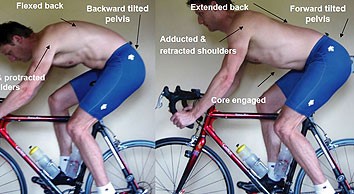
A client sent me these before & after photos posted by a physical therapist specializing in bike fit.
This is a great representation of bad information.
Yes, the “bad” position is not optimal, but it is absolutely better than the “good”.
Let’s Compare:
“Good”
- Forward Tilted Pelvis: Anterior pelvic rotation shifts center of gravity forward towards the hands, increases saddle nose pressure and reduces range of motion at the top of the pedal stroke (among other things). You can test this yourself. Sit on your bike and pedal backwards — repeat with the pelvis in anterior rotation (front of hips tips forward towards top tube). The resistance you feel is robbing power from the working leg, but more importantly leads to premature joint wear.
- Extended Back: Extending the back as demonstrated shifts the rider’s center of gravity to the bars, promotes/enforces everything wrong with the “forward tilted pelvis”, compromises upper/lower-body differentiation and reduces deep core stabilizer muscle recruitment.
- Adducted & Retracted Shoulders: Drawing the shoulder blades together and down, increases arm, upper-back, and neck strain, reduces trunk rotation and diverts blood flow away from the legs.
- Core Engaged: His “core” is acting to stabilize excessive upper body loading against lower body pedaling dynamics. Good for doing squats or standing, but not pedaling.
“Bad”
- Backward Tilted Pelvis. Yes. In that photo, he appears to be forcing his pelvis into posterior rotation, but not much. A neutral pelvis (not trying to rotate in either direction) will look similar for many cyclists. Improving muscle function that impacts pelvic orientation off-bike is great, but remember that the hamstrings produce force when pedaling (variant of Lumbard’s Paradox), so overstretching can be counterproductive.
- Flexed Back: What? Not flexed, but neutral. The spine will naturally assume an arch to combat gravity because this spine is now horizontal — common among quadruped species, and very effective for that orientation.
- Protracted Shoulders: Relaxed shoulders will appear somewhat rounded when cycling. His handlebars appear a bit low and far in this image, but he is also in the drops (which appear a bit deep). Shoulder muscle activation should be largely passive when riding a bike, even under higher loads. Relaxed shoulder rotation when pedaling demonstrates good upper/lower body differentiation while also reducing loads between the shoulders and neck.
Not convinced? Here is a test that you can try at home:
- Position yourself on your hands and knees with your back arched in extension (“cow-pose” for you yogi’s and yogini’s). Ask someone to sit on your back. What is your nervous system’s response to adding weight to your spine in that position? My guess is that you brace by moving into a spine orientation that is more like a leaf spring than a hammock.
- Position yourself again on your hands and knees with back arched in extension. Lift one knee, put it down, and then lift the other. Repeat with someone’s hands on your glute medius muscles. You’ll observe that they do not function in anterior pelvic rotation with the spine extended in a horizontal position. Now repeat the same exercise with a neutral spine (think Pilates; not “cow-pose) combined with a very slight posterior pelvic rotation. Do not tuck your tail (like the poser in the first image). Boom! There they are! Why? Because your pelvis is now oriented closer to the bipedal orientation.
- Now do an air squat. Notice that the hips move back/forward in the horizonal plane while you are doing that exercise? Do your hips move back/forward when cycling? I have spent years developing protocols to encourage glute recruitment while seated on a bicycle. Not going to share my trade secrets, but learning to squat in the vertical plane, standing from a position where the tush is touching your heels using primarily the large glute muscles — without sticking your ass out — is integral to the way these muscles function when cycling.
- Still not convinced? Stand with hands on your desk and march in place with “high-knees” — like pedaling a bicycle. Engage your lumbar spine to create a bit of an arch, as if standing with good posture. Now relax the back. Get it?
I personally know some very good physical therapists in the US who are also competent bike fitters. These folks have experience riding a variety of bikes in different positions, with different components, injuries, etc., but most importantly they consult with fit-specialists for complex bike-related issues.
Shopping for a competent PT for bike fitting?
In my opinion, they should meet the same criteria as average bike fitters:
Requirements for PT Bike Fitting (1.5-2.5-hrs)
- The cycling assessment on the bicycle producing physical symptoms or unbalanced performance. It is impossible to identify and treat fit-related issues without observing a person on his/her bike. 6-month of physical therapy will not fix symptoms originating from a broken or bent saddle, offset cleat placement, etc.
- Inventory of fit-related products and componentry. It is impossible to change the way a bike fits without changing parts, or at least adjusting the orientation of those parts. Stems, saddles, handlebars, cleats, pedals often need replacing to produce positive outcomes.
- Mechanical competency to inspect and/or install components to appropriate torque and manufacturer specifications. Sometimes the manufacturer suggestions list a range of adjustment. Experience tells a quality fitter where on that continuum is appropriate. The person adjusting a client’s bike is liable for that work and the operational safety of that bike. This extends beyond torque settings to variables including but not limited to tire choice, gearing choices, tire psi settings, component/frame compatibility and a keen eye for parts worn beyond a usable lifespan.
- A positive outcome guarantee for symptoms that occur ONLY when cycling. Pain, discomfort and/or injuries that are a product of poor bike fit can only be resolved through a proper bike fit specific to each client.
- Clear, detailed documentation includes all session notes, component specifications, contact points, and follow-up instructions. This documentation belongs to the client.
Cheers;)
